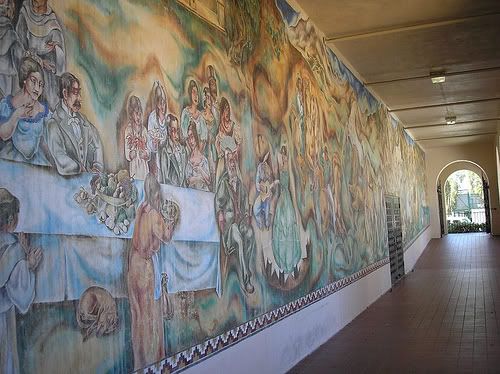C. Stanley Chapman, son of Fullerton’s first mayor, Charles C. Chapman, did not like the public murals commissioned by the WPA in Fullerton. When describing the mural “Pastoral California” on the side of Plummer Auditorium (painted in 1934 by WPA artist Charles Kassler), Chapman said:
“The one down there at the school was almost as absurd [as the one in the post office]. They were painted by that WPA business and the painting did not go with the architecture of the school. It was a great relief when they did paint them out. They were not an artistic addition to the building by any means” (CSUF Oral History Program).
The college student interviewing Chapman replied that Louis Plummer disagreed with this assessment: “Mr. Plummer seemed to think they were nice although he did not say so. He simply quoted a long article from the Los Angeles Times art critic who said they were lovely and truly representative and that the colors were beautiful. Mr. Plummer ends that little discourse by saying, ‘and they were painted over,’ as though he was disappointed.”
Chapman repied, “Oh, yes, the colors were good. But I have forgotten what the theme was.”
The interviewer reminded him, “Mexican entertainment; with the horses, and the children playing.”
Chapman replied, “Oh, yes, Well, the colors were nice. I don’t know. I was never involved in the school board or anything like that.”
It was not the school board who ordered the murals be painted over, however. It was the city trustees, which included Charles Chapman. They ordered it be painted over because it had “lurid colors and somewhat grotesque figures,” according to Bob Ziebell in Fullerton: A Pictorial History.
So, what was the problem with the murals? Was it the colors? The subject matter? And why did the City Trustees have the authority to paint over public art? They were business men, not art critics. As I suggested before, the decision to paint over this mural probably had to do with its subject matter. It celebrated Mexican culture at a time of great racism against Mexicans, and when Mexicans were being forcefully and illegally deported back to Mexico, because white people needed their jobs, during the Great Depression.
If C. Stanley Chapman did not like “Pastoral California,” what kind of art did he like? Inside the Chapman Theater (which became the Fox Theater), there used to be murals that were painted over when a new company took over the theater. Unlike “Pastoral California,” Chapman lamented the whitewashing of these murals: “On the walls—and I’ve often just about cried about this—on each side, there were these great big arches, and on each side a set of beautiful murals depicting early California, Portola’s landing and all that.”
Portola was the soldier sent by Spain in the 1700s to colonize California. It was he who began the long process of taking the land from Native Californians and forcing people into missions. He was white. The Native Californians were not. Chapman liked these murals, perhaps because they celebrated an aspect of history he agreed with.
Interestingly, the mission system, while defunct by the 20th century, was very similar to the system the Chapmans used with their Mexican workers. He said, “On our ranch, we had our own housing for them.” I wonder if that housing was as nice as the mansions the Chapmans lived in.
Who decides what counts as public art? I don’t know, but I don’t think it should be the City Council.

